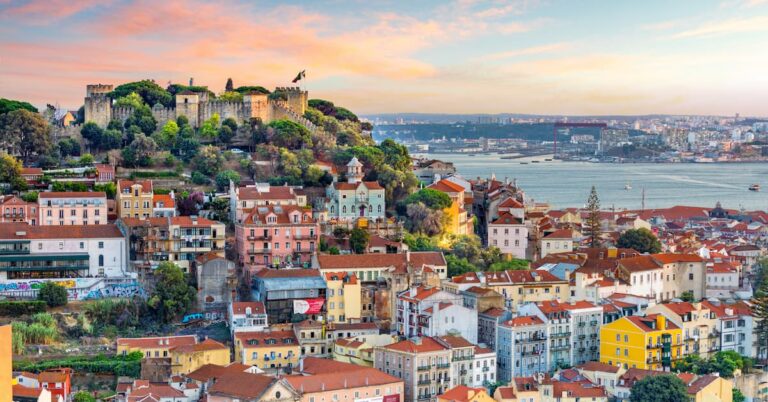
We are reader-supported and may earn a commission on purchases made through links in this article.
Welcome to Lisbon, where winding cobblestone streets take you through history, colorful facades and azuejos brighten your day, the aroma of freshly baked Pastéis de Nata fills the air, and passionate Fado transports you to another world.
This Portuguese capital, located on the banks of the Tagus River, is the oldest capital in Western Europe. The official language is Portuguese, but don’t worry, English is perfectly acceptable. For Pastéis de Nata and a glass of the best local wine, you will pay in the official currency, the euro.
Planning a last-minute trip to Portugal?
Top Experiences and Tours in Portugal:
- See the sights with a tour of Madeira: Skywalk, Porto Moniz Volcanic Pools, and Fanal Tour
- See Lisbon on the Lisbon: Pena Palace, Sintra, Cabo da Roca, & Cascais Daytrip
- Explore more with this tour of Fátima, Nazaré, and Óbidos Small-Group Day Trip from Lisbon
Where to stay in Portugal:
- Find accommodation with Booking.com
- Get a rail pass through Rail Europe
- Find Bus, Train, and Flight tickets with one search through Omio
If you choose wisely, you won’t have to worry about the weather either. Lisbon has a really nice climate, with long, hot summers and short, pleasant winters.
If you’re visiting this beautiful European city for the first time, here’s a travel guide to its must-sees and hidden gems. So, let’s get started with this 4-day Lisbon itinerary; there’s a lot to see.
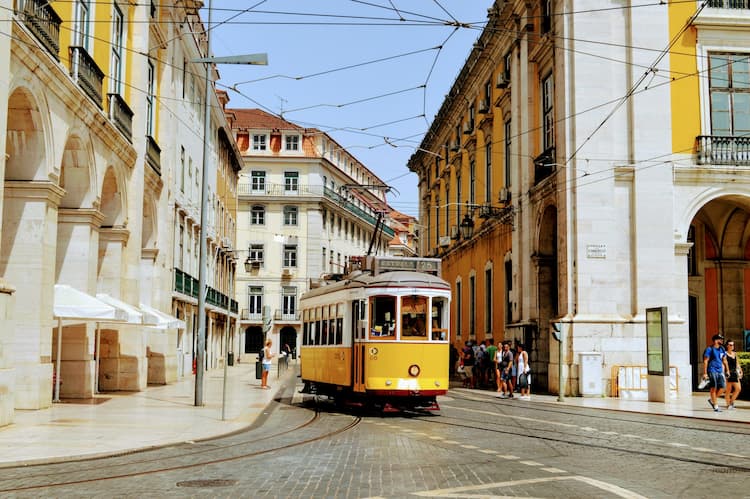
DAY 1
Hello Lisbon
Don’t we all enjoy the sound of suitcase wheels and the aroma of a new city? So hello, Lisbon. To begin, grab a cup of coffee to go and a bottle of water (trust me, you’ll need it while climbing the many stairs) and head to Alfama, the city’s oldest and most charming neighborhood.
That’s where you’ll find the well-known colorful facades and cobblestone streets, which are one of the main reasons people visit Lisbon. As a Croatian, many parts reminded me of Zagreb’s Upper Town and Istrian towns like Rovinj. But let’s go back to Lisbon.
A Travel Tip
I recommend that you purchase a Lisbon Card right away because it will grant you free admission to 39 city attractions as well as unlimited public transportation rides. A Lisboa card will cost you 22 euros for one day, 37 euros for two days, and 46 euros for three days.
You can purchase it online, of course, and I promise you’ll be glad you did, because it will give you direct access to some attractions. After all, who wants to waste half of their valuable time standing in lines? I certainly don’t.
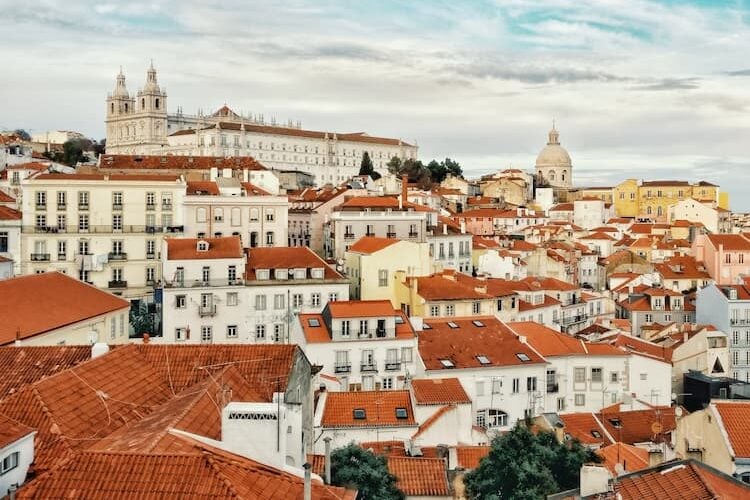
Best Tips & Tools to Plan Your Trip
Must-See: Alfama and Sé de Lisboa
When you arrive in the Alfama district, set your GPS aside. Take some time to enjoy the vibrant neighborhood, and don’t forget to treat yourself to a Pastel de Nata as a well-earned reward for climbing all those stairs. Don’t worry; you won’t have to go looking for them; they’ll find you.
After you’ve felt like a local for a few moments, turn on your GPS to avoid missing one of the most important sights: the 12th-century Lisbon Cathedral (Sé de Lisboa), which survived the devastating earthquake of 1755.
Fortunately, many reconstructions were able to preserve its unique blend of gothic, romantic, and baroque styles. There are a few viewpoints you should not miss, and one of them is the Miradouro Largo das Portas do Sol. Also, look out for the iconic Lift da Bica, a yellow funicular that connects Largo do Calhariz to Rua de São Paulo. Or, even better, take a ride in it.
Legendary Tram 28
Really, what would a trip to Lisbon be without taking an Instagram photo in front of Tram 28? According to legend, if you don’t do it, the Lisbon police will show up, delete all your photos, and kick you out of town. Joking aside, the lovely Tram 28 is an absolute must.
You’ll be able to catch it near the Lisbon Cathedral. But what should you do once you’ve entered it? I recommend going to the Miradouro de Santa Luzia, which many consider to be the most beautiful viewpoint in Lisbon. When you arrive, take a few moments to do nothing at all.
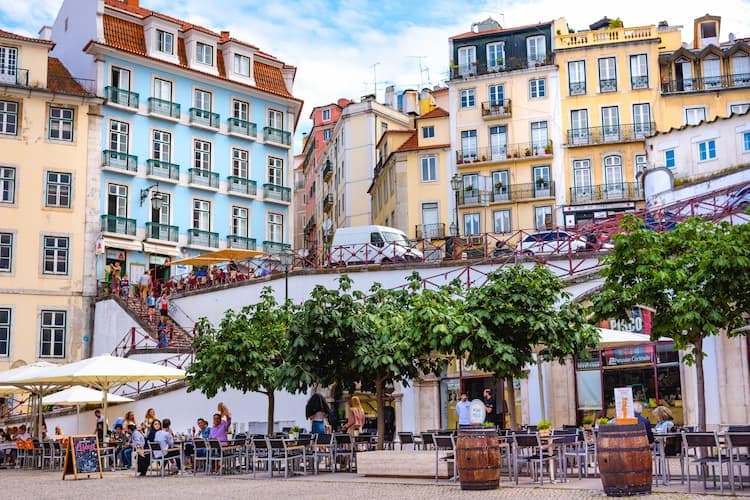
Down to the City Center
When you are ready to leave those beautiful views of Lisbon (don’t worry, there will be more), head down to the Praça do Comércio. The city center overlooks the port of Lisbon, while the southern end of the square overlooks the Tagus River.
Here’s a quick history lesson: It was built on the site of an old royal palace that was destroyed by a devastating earthquake in 1755, and it represents one of the world’s oldest examples of earthquake-resistant construction.
There is also a statue of Joseph I, the King of Portugal at the time, and the Arco da Rua Augusta, which was constructed to honor the city’s triumph over the earthquake. But let’s return to more positive topics.
Baixa is the best shopping district, and if you want to buy magnets as souvenirs, the main street, Rua Augusta, is the best place to do so.
Enjoy discovering the luxury of Chiado, sightseeing the black and white patterns of Calçada Portuguesa in Rossio Square, visiting the Monumento aos Restauradore (which commemorates the restoration of Portuguese independence from Spain in 1640), admiring Carmo Convent, and visiting the world’s oldest bookstore. And finally, reward yourself with an unforgettable view.
Picture-Perfect: Lisbon from Above
Ladies and gentlemen, it’s time for Elevador Santa Justa and, according to many, the city’s most beautiful view. The Lisbon Card grants free entry; without it, the return ticket costs 5.15 euros.
Additionally, here is a fun fact: The Santa Justa Lift was designed by Raoul Mesnier du Ponsard, a student of Gustave Eiffel. Of course, lines can get quite long, so consider whether you really want to wait. And then, with all that beauty (and stairs), you might get hungry. So, what should you eat?
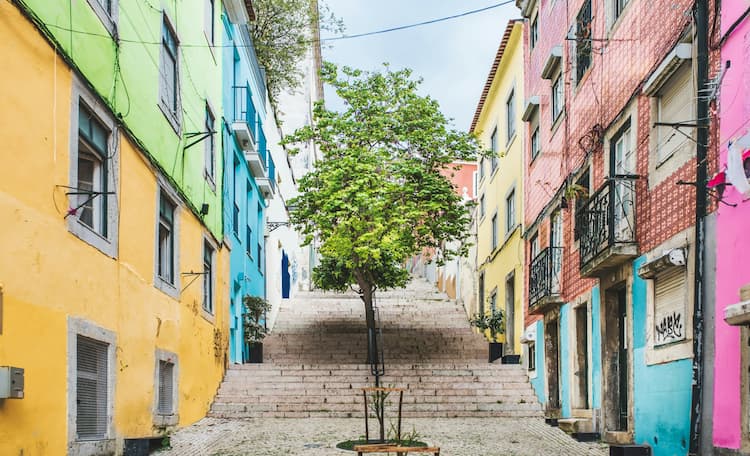
Time Out Market: Food Please
Food always perfectly reflects culture, so trying Lisbon cuisine isn’t a waste of money; it’s a step closer to getting to know the city, right? So, I recommend that you visit the Time Out Market in Cais do Sodré. Why? Because, in 2014, Time Out Portugal gathered dozens of top-tier restaurants in one location, and all of the food is a trusted choice of gastro professionals.
If you want cod, order Bolinhos de Bacalhau or Bacalhau à Brás; if you want traditional Portuguese soup, order Caldo Verde; and if you want Portuguese stew, order Cozido à Portuguesa. For a sweet treat, go with Arroz Doce or Pastel de Nata. So, bon appetit.
DAY 2
But first…Coffee
It’s always an amazing experience to wake up in a new country, isn’t it? But where to begin with sightseeing? First and foremost, I recommend the best coffee and breakfast at Chiado’s popular Café A Brasileira. After that, you’ll be ready to visit Belém and the Belém Tower, a UNESCO World Heritage Site built to protect the city from invasions.
Mistery Cookie
Here, you should treat yourself to another Pastéis de Nata, but this time at Pastéis de Belém. Why? According to belief, this is the birthplace of this confection, and only one family in the world has the original recipe, which was purchased from the monks of Jerónimos Monastery in 1837.
Everyone always agrees that these custard tarts are truly the best here. After that, it’s time to visit the mentioned Monastery of St. Jerónimos, which was built in the Portuguese Late Gothic Manueline style, and admire its historic cloisters. Or the recipe. Whatever you prefer. By the way, did you know that the famous Vasco da Gama is buried there? So, now you know.
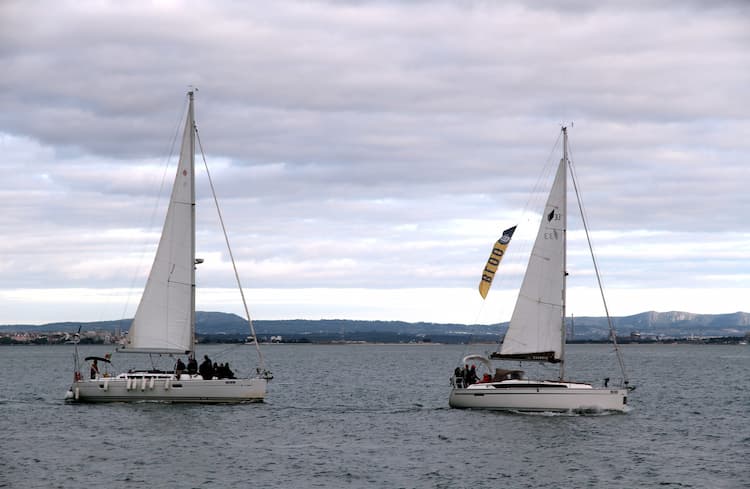
Tired of Walking?
Traveling can be quite intense; time is limited, and there is so much we want to see and do. If you get tired of your walking tour, consider taking a one-hour Tagus sailing tour as a break. You’ll be able to relax, and the water provides a beautiful view of the city. Isn’t this a true win-win situation?
To further recharge your batteries, I recommend a meal at the LX Factory in Alcantara. The former fabric processing factory now houses over 200 small businesses, including restaurants.
But if you want to fully immerse yourself in this European city, I recommend going to the Mercado da Ribeira because nothing smells more local and authentic than the markets, right?
So you can try fresh local cuisine, such as the francesinha, a Porto-based Portuguese sandwich. You will not be disappointed; this is more than a sandwich, and yes, it will suffice. Also, I recommend taking a tuk-tuk ride at some point—a three-wheeled mode of transportation for sightseeing—in an unusual and interesting way. Of course, remember to negotiate over the price.
And… Something Pink
Add a pop of pink to your day by visiting the charming Pink Street (Rua Nova do Carvalho), one of Lisbon’s most visited streets. I can assure you that it’s a true gem for anyone searching for picturesque settings.
This area transforms into a real party zone at night, thanks to the numerous bars, live music venues, burlesque clubs, and restaurants. After all of this, you truly deserve to take a rest in your apartment or hotel. Or stay a little longer and order a glass of wine. It’s up to you.
DAY 3
Are you ready for a road trip to a Portuguese fairytale? I’m sure you are. There are several popular day trip destinations, such as Cascais or Óbidos, but the majority will go with Sintra. So, let’s see what’s so special about this place.
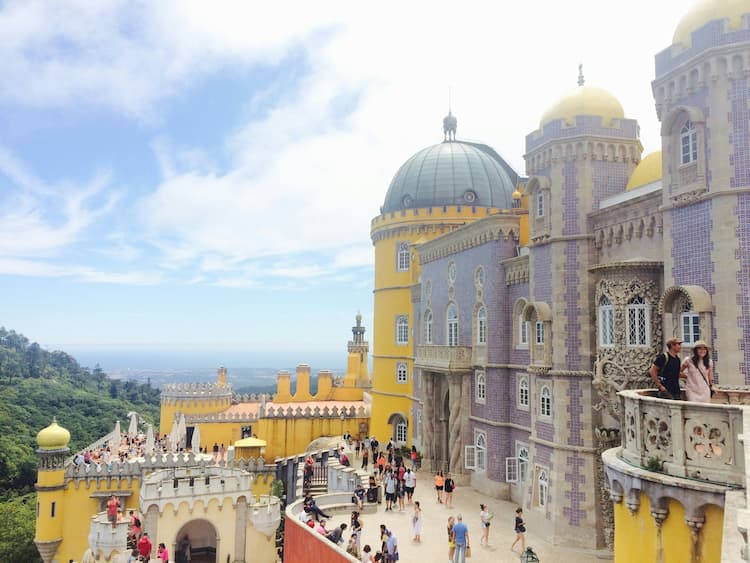
Sintra Day Trip Itinerary
To get to the stunning Sintra, you can take one of the many guided tours. Or if, like me, you prefer to travel at your own pace, I recommend taking the train. This amazing place is only 25 kilometers away, so a 40-minute drive to the Sintra train station will cost you only 4.50 euros.
I recommend eating there, and the locals recommend the chicken empanadas. Listen to them because locals know best.
If you’re looking for the perfect shot, trust me, this day tour will fill your memory card. Of course, Sintra’s fantastical fairytale settings are a UNESCO World Heritage Site. If you only see one thing here, make it the stunning Pena Palace (Palácio da Pena), a beautiful, colorful 19th-century palace with incredible surrounding nature.
You should also see the Castelo dos Mouros (Moorish Castle) walls, the Sintra National Palace, and Quinta da Regaleira.
When you’re tired and hungry, I recommend recharging your batteries at Bacalhau na Vila restaurant, and while you’re in Sintra, try Queijadas (an egg, milk, sugar, and cheese cake) or Travesseiros (an egg and almond cream puff pastry). Or perhaps both. When you return to your hotel, take some time to relax. But not for long.
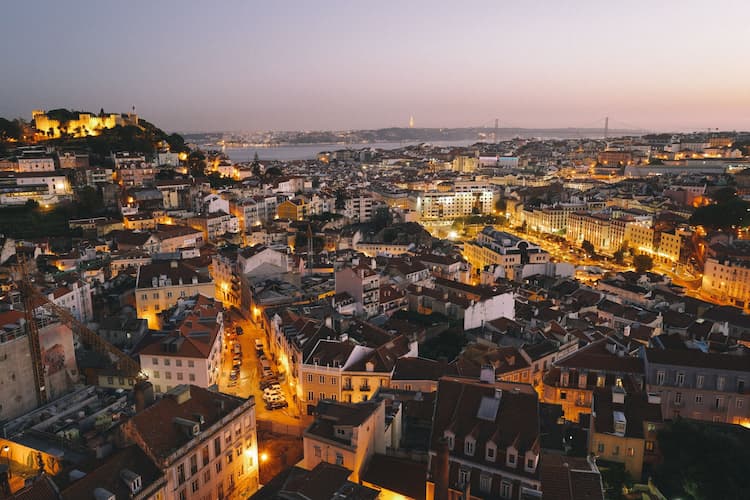
Ready For the Show?
Lisbon is well-known for its vibrant nightlife. If you want to experience it, go to Bairro Alto, which is known for its street art and nightlife. Or, instead of a traditional night out, go to a Fado show, which is one of the city’s most popular forms of live entertainment.
Because, while you can have a classic night out in your own city, there is only one place where you can truly experience traditional melancholic Portuguese music: Portugal. Of course, as with any world-famous attraction, Fado nights can be quite pricey, so choose wisely. Locals will direct you to Tasca do Chico. Again, listen to them.
Trust me when I say that the incredible emotion of passionate Fado will awaken a part of you that you didn’t even know or forgot you had. Yes, even if you don’t understand one word. And if you add a glass of Portuguese green wine… However, don’t overdo it. Tomorrow is a new day.
DAY 4
Are There Any More?
These were three very busy days, but Lisbon has a lot more to offer, so I recommend you keep up the pace on the fourth day.
If you need to slow down, check out the top attractions that pique your interest the most. Visit the 16th-century Graça e So Vicente and São Jorge Castle, or go to the local flea market to find genuine treasures such as antiques, handicrafts, and secondhand goods.
So, if you want to bring home a truly one-of-a-kind souvenir, you know what to do. Keep in mind that it is only available on Tuesdays and Saturdays.
Even without my recommendation, I’m sure you’ll want to visit the National Tile Museum (Museu Nacional do Azulejo). You might also want to see the Oceanário de Lisboa and the 25 de Abril Bridge (Vasco da Gama Bridge). This longest bridge in Europe, spanning 17.2 kilometers over the Tagus River, survived the devastating earthquake in 1755.
And finally, you can say you’ve seen pretty much everything. The only thing left to do is start planning your comeback, because you can already hear Fado starting a melancholy song about your departure.
Inspire your next adventure with our articles below:

